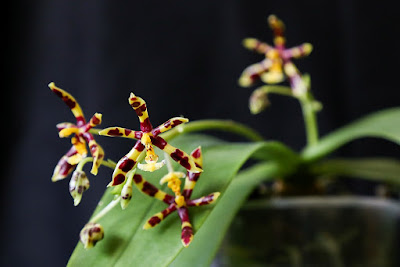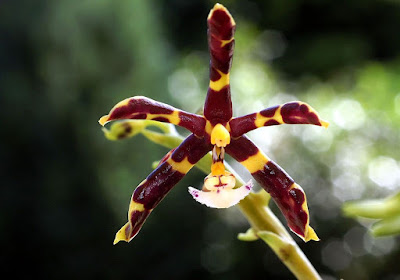Mann's Phalaenopsis is native to the eastern Indian Himalayas, Assam, Nepal, Bhutan, Sikkim, Myanmar, southern China and Vietnam, at an altitude of about 457 m. It grows usually near forest streams or marshes, which together with dense forest undergrowth gives high humidity throughout the year, despite the dry conditions in the adjacent areas. Plants grow 3-5 m above the very dark forest ground, on trees with rough bark.
Phalaenopsis mannii orchid, also called as Mann's Phalaenopsis (named after a German orchid enthusiast Gustav Mann), Phalaenopsis boxalli, Phalaenopsis mannii f. flava, Polychilos mannii, is a species of the gens Phalaenopsis. This species was described by Reichenbach in 1871.
IDENTIFY PHALAENOPSIS MANNII ORCHID
Mann's Phalaenopsis is native to the eastern Indian Himalayas, Assam, Nepal, Bhutan, Sikkim, Myanmar, southern China and Vietnam, at an altitude of about 457 m. It grows usually near forest streams or marshes, which together with dense forest undergrowth gives high humidity throughout the year, despite the dry conditions in the adjacent areas. Plants grow 3-5 m above the very dark forest ground, on trees with rough bark.
Phalaenopsis mannii is a small to just medium sized, warm to cool growing, epiphytic with a short stem enveloped by imbricating leaf bases carrying 4 to 5, oblong-oblanceolate to oblong-ligulate, shiny, fleshy, acute, medium green leaves. The leaves are 15-46 cm long, they have purple spots.
It blooms in the spring, on a slender, pendulous, to 18" (45 cm) long, racemose or rarely paniculate, laxly many (to 70) flowered inflorescence that is as long as the leaves with small ovate-lanceolate bracts with fragrant, waxy, long-lived flowers. The flowers with a diameter of 2.5-5.0 cm open successively one after the other and hold for 3 months. They are parted, star-shaped and slightly curved. The flakes of both whorls are yellow to brown and usually have reddish spots, but they can also be pure yellow, while the lip of the shape of the anchor is white and purple, with short claws.
GROW AND CARE PHALAENOPSIS MANNII ORCHID
Cultural information should only be used as a guide, and should be to be adapted to suit you. Your physical location; where you grow your plants, how much time you have to devote to their care, and many other factors, will need to be taken into account. Only then can you decide on the cultural methods that best suit you and your plants.
Light:
Phalaenopsis mannii needs a very little light level, about 8000-10000 lux, and like shady areas. The ideal photoperiod is 12 hours.
Temperature:
It is a thermophilic plant. In summer, the average day temperature is 29-30 ° C, night 21-23 ° C, which gives a daily difference of 7-9 ° C. In winter, average daytime temperatures are between 21-27 ° C and night 8-14 ° C, with a daytime winter amplitude of 12-14 ° C.
Humidity:
A humidity of 85-90% is recommended. The microclimate near streams and marsh indicates that the plant requires high humidity.
Substrate, growing media and repotting:
Due to the dangling shape, I recommend pads. The most popular substrate for plants grown in pots is bark with a grain size of 12-16 mm, but plants can also be successfully grown in charcoal covered with sphagnum moss.
Repotting is best done just after flowering, when the growth of new roots begins. With age, the roots grow very long and often grow up to 3-4 m long, crawling along the trunk of the tree.
Watering:
From March to September, the Phalaenopsis mannii requires abundant and frequent watering, especially during the summer months. It gets weter as soon as the substrate has become almost, but not completely, dry. In October, the watering begins to decrease, and from November to February, together with the lowering of the temperatures, they are reduced until leaving the orchid in the completely dry substrate for 3-4 days between waterings. In February, the watering, together with the temperatures, increased a bit to reach normal levels in March.
Fertilizer:
The Phalaenopsis mannii can be fertilized only from March to October, using 1/4-1/2 of the dose indicated on the bottle of a special liquid manure for orchids. The fertilizations take place every 3 watering. Before fertilizing the orchid it is important to water it: the fertilizer must be applied only to the roots already wet to avoid any burns.
Rest period:
A 3-5-months cool and dry resting period is required. When the plant is not growing, fertilization should be discontinued. During the 3 winter months, when the humidity are high and the temperature are low, you can increase the level of light, but the amount of water should reduced to every 2 or 3 weeks because the plant needs a distinctly drier winter rest that helps initiate spring blooming.















COMMENTS